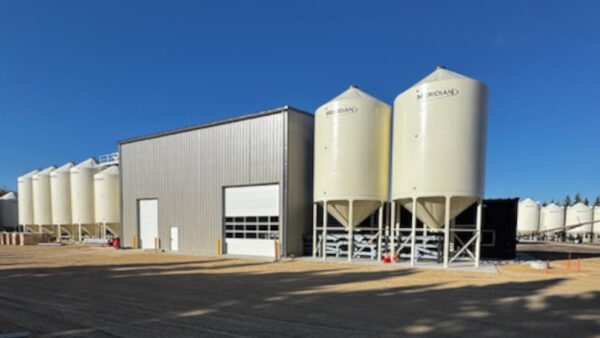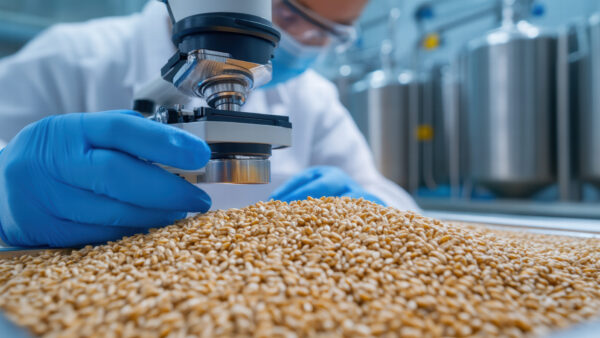
A growing population needs food. We need to grow more with less. Technology continues to improve seed innovations. Exciting opportunities lie in the pipeline. The regulatory landscape is evolving. There has never been a more exciting time to be a part of the seed industry.
It’s a good time to be in agriculture and particularly in seed—innovation is at an all-time high, and with a growing population it doesn’t look like that will slow down any time soon. In response, the Canadian seed industry is evolving and industry professionals have never been more excited. “What we’re seeing today is one of the most dynamic and robust environments that we’ve ever seen within the seed industry,” says Stephen Denys, vice-president of sales and marketing for Pride Seeds. “And that’s really reflected in the activities that we’re seeing across the country within the seed industry.”
Denys is also the president of the Canadian Seed Trade Association, so he’s well positioned to speak on the trends the industry is focused on for the coming year. “One of the things we’ve seen for a number of years, but will probably increase in coming years, is that seed is seen as the vehicle to bring new technology to producers. That can either be through genetics or it can be through traits or it can be through seed treatments,” explains Denys. “We’ve seen a great deal of investment in the seed industry from companies that offer products beyond traditional genetics development, and we are seeing involvement of these companies within CSTA as well. So this is a sign of a healthy investment environment within the industry. It has really raised the plateau of seed in terms of being the vehicle of technology transfer to the producer. So it’s an exciting time from that perspective.”
Creating Efficiencies, Increasing Value
Denys says the name of the game for the seed industry today is developing simpler solutions that allow for efficiency while increasing the value of seed. “Producers today, as they increase in size, are looking for efficiency,” says Denys. “And, particularly, efficiencies at planting because they are trying to get a large number of acres in the ground during a very small window of time in the spring. The seed industry is developing a range of solutions to simplify things for the producer.”
Denys says solutions range from providing corn refuge in the bag to preinoculation of soybean seed at the seed processing or retail facility. However, he notes that as the industry develops simpler solutions for the producer, it often makes things more difficult and less efficient at the processing level.
“There are additional costs on the seed processing side which need to be reflected in the value of seed that’s now being sold to the marketplace.”
—Stephen Denys
“All of these things hold a great number of benefits for the producer in terms of efficiency, in terms of the product that is going into the ground,” says Denys. “But there are additional costs on the seed processing side which need to be reflected in the value of seed that’s now being sold to the marketplace. I think growers in general, particularly in this type of commodity environment, understand that to make things more efficient for them, to see that additional value through the year in their crops, they need to and are willing to pay the additional price that it takes to get that value to the field.”
Regulatory Landscape Evolving
While there are many exciting things happening in seed, none of it matters unless we have a policy framework that facilitates investment in the industry. “We need recognition that in order for Canadian producers and the Canadian seed industry to be competitive on a global scale, we have to have a policy framework that supports investment in innovation,” Denys says. “And I think what we are seeing today is not only support from producer groups, but also support from the government to change some of the policies that have actually been putting Canada behind on a competitive level around the world.”
There is no question that the regulatory environment in Canada is changing, and nowhere did we see that more this year than in the Canadian Food Inspection Agency’s announcement on seed certification. “[Changes to seed certification] are going to be a big challenge,” says Roy van Wyk of the Canadian Seed Institute. “CSTA, CSI and the Canadian Seed Growers’ Association are all providing feedback and working with CFIA to see what can be done and what kind of solutions can be in place to replace approximately 100 to 120 casual staff that help look after crop inspections each year. It’s a bit of a challenge to try and picture how that path will look moving forward—we’re still pretty early in the stages of the discussions and we really need feedback from industry right now—what kind of interest is out there to take on the responsibilities or roles of inspecting the crops.”
Investing in Wheat
The desire to add value and improve the Canadian producer’s toolkit of products has led to one of the most exciting opportunities in the industry today: increased investment in wheat. “When you look at the number of acres out there and you look at the vast array of different types of products that we can produce, and produce well in Canada, we’re really just embarking on a whole new frontier in terms of the types of varieties that we can grow and the types of markets that we can access,” says Jeff Reid, general manager of SeCan. “Look at hard white spring wheat, for example, now that’s really just getting ramped up in Western Canada. I think those types of things are going to present tremendous opportunity for the seed industry and for farmers across Western Canada.”
While the timeline for new wheat varieties is still somewhat up in the air, one thing is certain: investment will continue and will likely lead to more private and public partnerships. “SeCan has been a fairly large private sector investor in wheat for about the last 15 years, but I think going forward we see increasing opportunity for SeCan to leverage up dollars with other private sector partners as well as the federal government—while they are scaling back their own research and development activities they are willing to partner and certainly look at more partners outside of AAFC,” says Reid. “In recent years we’ve heard a lot more about private sector investment in wheat, but a lot of that is really still out on the horizon—we haven’t seen a lot of activity on the ground yet at this point. Undoubtedly that’s coming, and that’s going to be a very positive thing for the entire industry.”
David Hansen, president and CEO of Canterra Seeds, agrees. “Companies are now taking the tools that have been developed for other crops and utilizing them to help advance wheat on a major scale, on a global scale,” he says. Hansen says work on hybridization of wheat has been ongoing for many years but trying to perfect a system that will actually work economically on a large field scale has been very challenging. While he says the industry is closer to that end point than in the past, the introduction of GM wheat is likely still a few years away due to lingering consumer concerns.
“I think we need to talk more about GM wheat, in particular the traits and the values we want to see and in what sort of format they come to the market because there is a lot of sensitivity in terms of public acceptance,” says Hansen. “The technology is certainly available and can be adapted and incorporated into wheat programs relatively quickly for the benefit of the grower, the industry and, ultimately, the end user and consumer, but I think we are all well aware that we need to tread carefully. However, I firmly believe that we will see hybrid wheat and GM wheat in certain market segments where it makes sense and where it is not impeding trade and marketing of the commodity.”
In order for Canadian producers—and the Canadian seed industry—to be competitive on a global scale, a policy framework that supports investment in innovation must be in place.
New Role of Seed Growers
What will the introduction of some of these exciting new traits and genetics, especially in cereals, mean for the traditional seed grower? “I think going forward the introduction of new traits and genetics will change the landscape somewhat, but maybe not as much as people think,” says Reid. “You always hear the saying that ‘wheat is grown, processed and distributed 50 miles at a time.’ And that’s really what sets the cereal industry apart from canola—where canola can be centrally produced, and really needs to be because of the costs associated with hybrid seed production, cereals really lend themselves well to localized production, processing and distribution.”
Hansen agrees and believes seed growers might even play a more important role in cereal seed production than ever before. “When we look at wheat as a crop, it has a very, very low multiplication rate, and if we look at the economics and the logistics of growing wheat or cereal seed of any type, moving it from point A to point B is very expensive and very labour intensive,” he says. “Therefore, we can’t relocate wheat production to another part of the country similar to what we have seen happen in canola, which has a very high return or high multiplication rate. So cereal crops are going to be worked within a 100- to a 50-mile radius of where that crop has been produced and how it’s going to be sold. Seed growers are the ones that the industry is going to be reliant on to help move the technology, move these traits, move these genetics into the hands of the farm customer.”
Educating Producers
An increase in new traits and genetics in the marketplace means the industry needs to get better at communicating with producers, not just to explain the increased value of the seed and how it will perform better, but also to help them understand why their investment is important.
“As we look across the country, we still have a number of producers who do not see the value of investment in seed innovation. In crops like corn, canola and soybeans, where there has been investment, we’ve seen farmers pay for the technology and have access to a tremendous range of new tools that they didn’t have before.”
—Stephen Denys
“As we look across the country, we still have a number of producers who do not see the value of investment in seed innovation,” says Denys. “In crops like corn, canola and soybeans, where there has been investment, we’ve seen farmers pay for the technology and have access to a tremendous range of new tools that they didn’t have before, which produce both higher yields and provide better agronomics in the field. Producers see value in these advancements as evidenced by the wide and rapid adoption of these technologies. What we want to see is an environment in Canada where producers of crops such as cereals see seed innovation in those crops.”
But it will take communication and education. And that doesn’t just land on seed companies and retailers; it is an entire industry effort. “I think we have a lot of work to do in educating the end user with seed,” says Sarah Foster, president of 20/20 Seed Labs. “That’s one of the beauties of this particular industry—there is always something challenging, there is always something on the horizon and I think it’s important that we get those messages out. I think Twitter right now is huge—if we want to speak freely about information that’s one of the ways we can do it. And I think large seed companies that are selling seed can go a long way in terms of offering good products and can do a lot to get that message out by letting products speak for themselves.”
However, none of these initiatives will be viable long term if the industry doesn’t ramp up its efforts to attract talent to the seed industry. “There has never been a better time to be in the seed industry than where we are today,” says Denys. “And there are a number of different roles that individuals can play within the industry—because it’s such a dynamic environment you do not have to become fixed in one role. So it becomes an attractive industry not only to agricultural students but I think we need to reach out beyond that. If we can be successful at expanding our outreach, we can attract a strong talent pool for all of our members so that we can go into the future confident that we’ll be able to meet the needs of our customers.”
Julie McNabb













